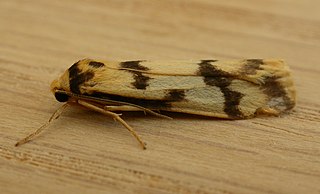
Tigrioides is a genus of moths in the family Erebidae. The genus was erected by Arthur Gardiner Butler in 1877.
Max Gaede was a German engineer and entomologist of international fame who described several hundred of new species of Lepidoptera, mainly African Noctuidae.

Heliozona dulla is a moth of the family Erebidae first described by Arnold Pagenstecher in 1886. It is found on the Kai Islands and Papua New Guinea.
Lambula hypopolius is a moth of the family Erebidae first described by Walter Rothschild in 1916. It is found along the coastline of northern New Guinea, from Papua New Guinea and Karkar Island to Batanta Island.
Lambula buergersi is a moth of the family Erebidae. It was described by Max Gaede in 1925. It is found in Papua New Guinea. It was previously only known from Mulu, the type locality, but was later also collected in the Foja Mountains.
Darantasia cuprea is a moth of the family Erebidae. It was described by Walter Rothschild in 1912. It is found in New Guinea.
Lambulodes albiterminalis is a moth of the family Erebidae. It was described by Max Gaede in 1926. It is found in New Guinea and Papua New Guinea. The species is probably restricted to mountainous areas.
Crocodeta erecta is a moth of the family Erebidae first described by Max Gaede in 1925. It is found in Papua New Guinea.
Nishada impervia is a moth of the family Erebidae first described by Francis Walker in 1864. It is found in New Guinea, Papua New Guinea and on Seram. The habitat consists of lowland areas.
Gymnasura costaesignata is a moth of the family Erebidae. It was described by Max Gaede in 1925. It is found in Papua New Guinea.
Prosiccia trifasciata is a moth in the family Erebidae first described by Max Gaede in 1925. It is found in New Guinea.
Scoliacma heringi is a moth in the family Erebidae. It was described by Max Gaede in 1925. It is found in Papua New Guinea. The habitat consists of mountainous areas.
Spilarctia grandimacula is a moth in the family Erebidae. It was described by Rob de Vos and Daawia Suhartawan in 2011. It is found in Papua and Papua New Guinea. It has been recorded from the Central Mountains in western Papua, east into Papua New Guinea.
Teratopora haplodes is a moth in the family Erebidae. It was described by Edward Meyrick in 1889. It is found in New Guinea, where it has been recorded from Papua New Guinea and Papua. The habitat consists of lowland areas.
Teratopora unifascia is a moth in the family Erebidae. It was described by Walter Rothschild in 1912. It is found in New Guinea, where it has been recorded from Papua New Guinea and Papua. The habitat consists of lowland areas.
Tigrioides chionostola is a moth in the family Erebidae. It was described by George Hampson in 1918. It is found on New Guinea.
Tigrioides euscia is a moth in the family Erebidae. It was described by George Hampson in 1914. It is found on New Guinea, where it is only known from the Star Mountains in Papua New Guinea.
Tigrioides grisescens is a moth in the family Erebidae. It was described by George Thomas Bethune-Baker in 1908. It is found in New Guinea, where it is found in Papua New Guinea and the Central Mountain Range in Papua.
Tigrioides schraderi is a moth in the family Erebidae. It was described by Max Gaede in 1925. It is found in New Guinea, where it is found in Papua New Guinea and the Pass Valley in the Jayawijaya Mountains in Papua.
Zygaenosia medialis is a moth in the subfamily Arctiinae. It was described by Max Gaede in 1925. It is found on New Guinea.

